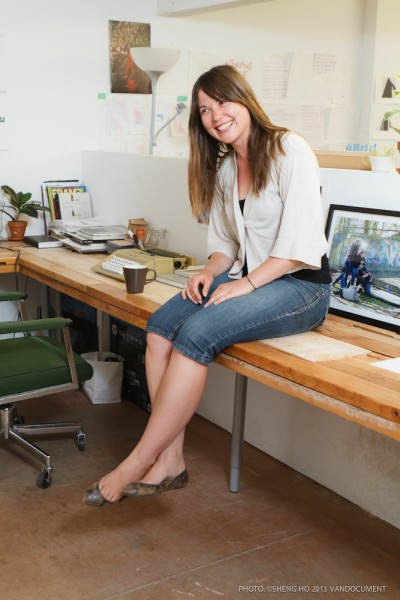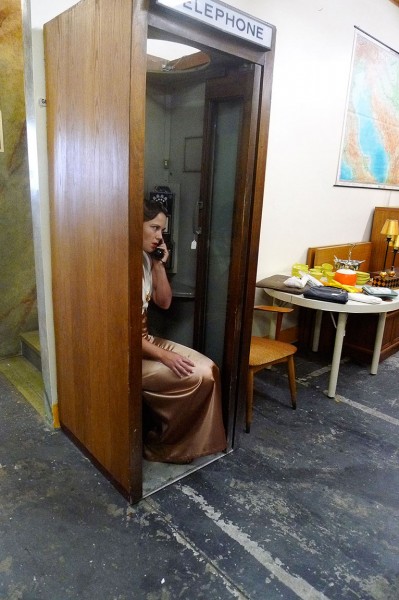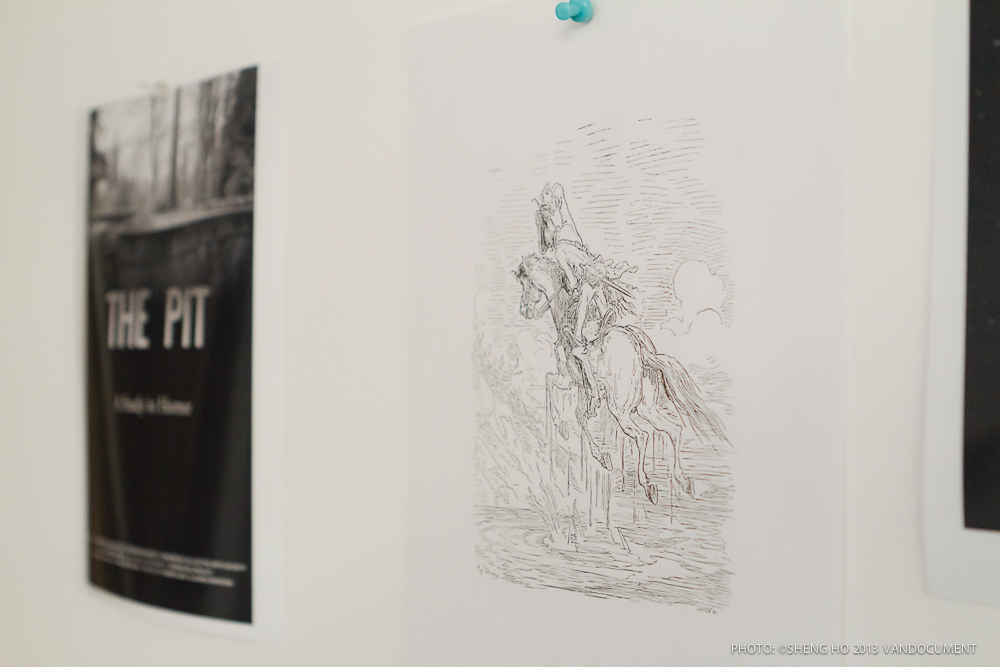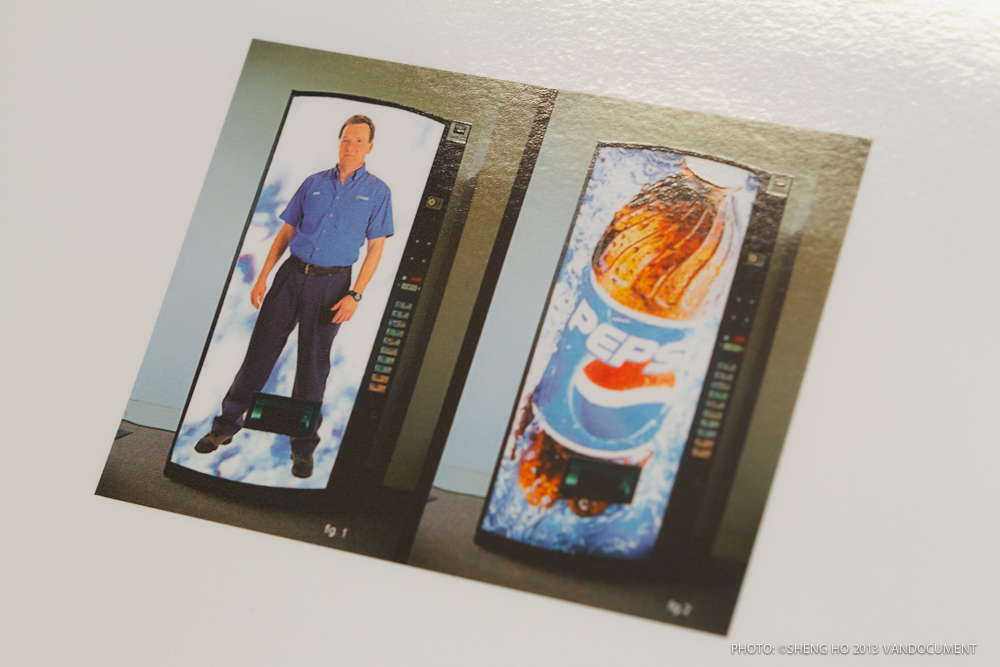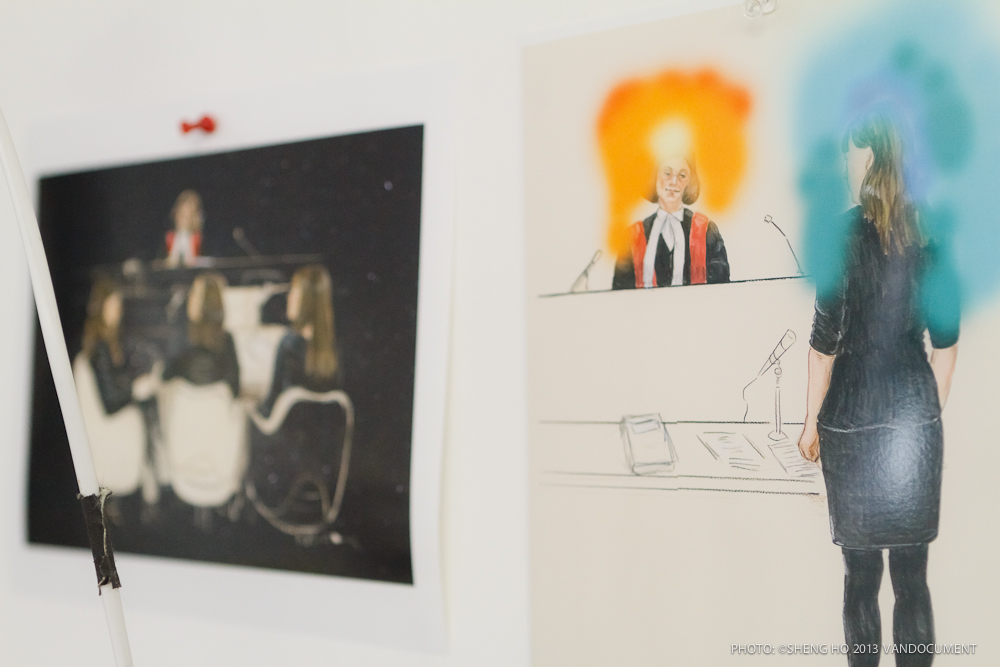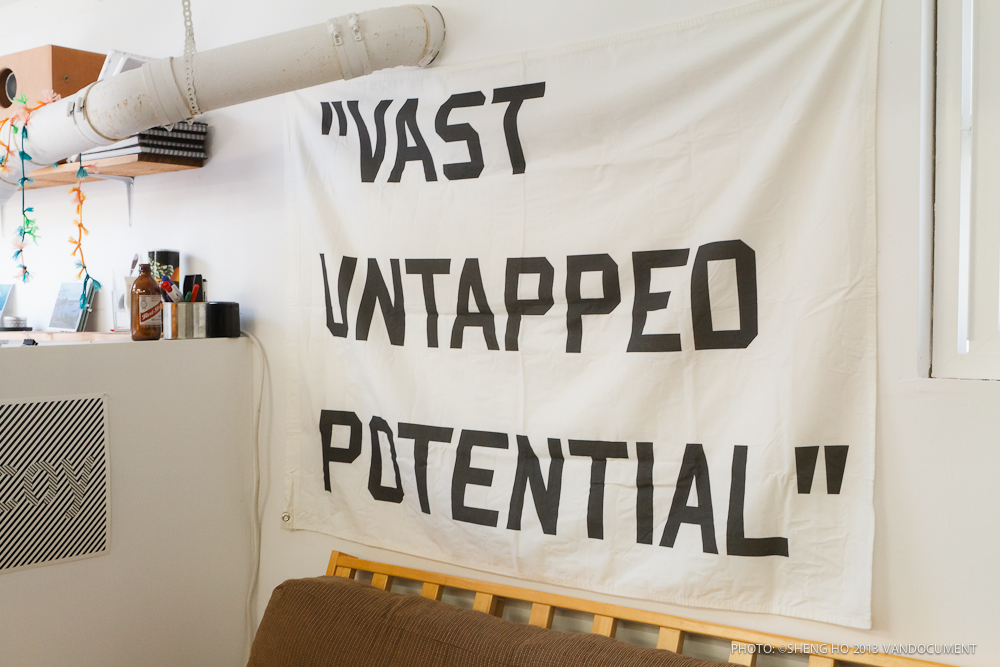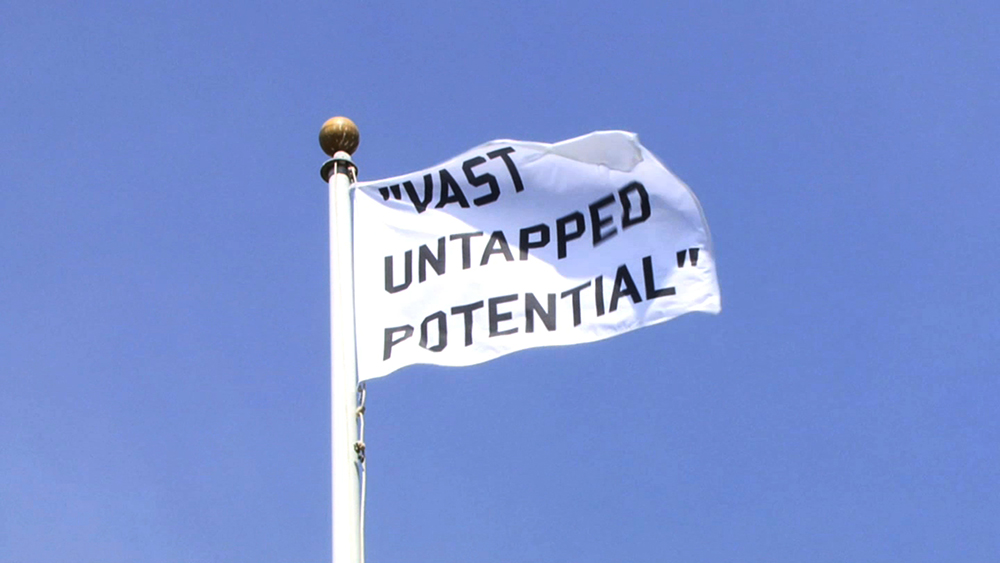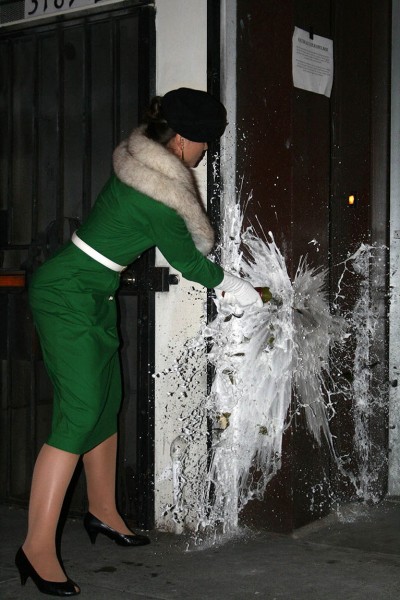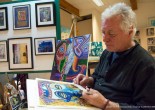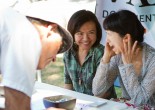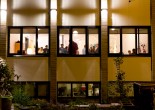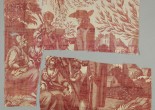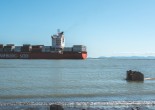Interview with Video & Performance Artist Lauren Marsden
An in-studio interview and on-site location visit reveal the history of Marsden's artistic practice and hint at where she's going next
Interview by Celesse McCarthy
Videography by Sheng Ho
Editing and post production by Ash Tanasiychuk
Special thanks to Lauren Marsden for sharing her time with us.
In studio interview: VANDOCUMENT talks to video and performance artist Lauren Marsden
Video and performance artist Lauren Marsden invites VANDOCUMENT to her studio to talk about the evolution of her practice, including her move from Vancouver to California and back, the effect that space has on her work and her characters, as well as hint at her newest piece, “The Auction #1,” in which she works with a professional auctioneer.
In studio interview: VANDOCUMENT talks to video and performance artist Lauren Marsden from VANDOCUMENT on Vimeo.
—
Transcription of VANDOCUMENT’s full in-studio interview with Lauren Marsden, Chinatown, Vancouver BC, July 14 2013
V: If you just wanted to introduce yourself.
L: No problem. My name is Lauren Marsden, I’m an artist based in Vancouver. I’m also the editor of Decoy magazine which is a project that’s online. It’s been around for about a year and a half.
And I have a studio here behind Access Gallery, and I do mostly video and performance work and text based work.
V: Do you have an upcoming exhibit?
L: I do. There are a few projects coming up. The most pressing one is a performance at Trench on July 25 (click here for VANDOCUMENT’s photos from Lauren Marsden’s and Mike Bourscheid’s performances). They have a group exhibition called Monomania II; it’s a ton of emerging artists. I have a video piece in that show and the show has already opened but they’re also going to be doing a performance night, so I’ll be doing a performance. I believe there will be 1 or 2 other performers.
V: What is your performance focused on? Can you give us a little bit of detail?
L: Yep, I can give you a bit of a preview. I’ll be working with an auctioneer. I won’t actually be performing but I am directing the performance. The auctioneer’s name is Crystal Campbell. She is based here in Vancouver, and she does all kinds of auctioneering. She works with antiques, fine art, and automotive auctions. So I’ve directed a performance for her to perform an auction at the gallery. It’s called The Auction #1. It’ll be the first instalment of a series of three auction performances that I’ll do in my lifetime. And that’s to be determined: when, where, and with whom I’ll be doing the next two auctions, so this is the first time.
V: In your previous works, you’ve worked with objects; you’ve mentioned antiques at the SC 13 in San Francisco. If you wanted to explain a little bit of that in your motivation behind that…
L: There’s not a huge relationship between the fact that I did a performance in an antique mall and the fact that I’m working with an auctioneer. They’re both in the world of performance art, but they’re not really related pieces. And I don’t want to explain too much about The Auction performance because there is a bit of surprise element to it and we’re very careful about how we’re… it’s just going to be a conceptual piece. It’s going to be a bit of a surprise, I think, to the audience. And it will be a real live auction and we are promoting it that way but as to what’s being auctioned, that’s something we’re not really telling yet. But basically the auction sells itself. So you’ll see. And there aren’t really any objects involved in this auction, so it’s an object-less auction.
V: I guess that kind of explains how there’s not really a relationship. When I was looking at your previous works, I noticed that there was sort of a note that looking at objects as though they’re estranged from time, and timeless ideals. So how do you conceptualize objects?
L: The way you just said it is quite interesting to me. Thinking of them as a portal through time and possibly a site of a time travel experiment, because I think that objects – of course when they’re older, and depending on what context they’re in – can have a real historical life to them. So I feel like you’re more addressing the antique mall piece, which really was a performative relationship with objects. And I can describe it a little bit.
I was invited to perform in an antique mall as part of a show called SC 13, which was curated by Post Brothers and Chris Fitzpatrick. It was a six month exhibition. They actually rented an exhibit – one of those glass booths of the antique mall and they were putting artworks into that glass booth, even though they’re surrounded by what would not necessarily be called artworks but antiques. So they were kind of intervening in the space of an antique mall, which is not normally an exhibition space or an art space. And so some of the objects looked like antiques, but they weren’t, they were actually artworks. So it was a very very subtle show, but they wanted me to do a performance, which was not a subtle thing at all. I thought, how can I put, not myself so much, but my body and my person, into this space full of objects, of historical objects, where there is a lot of time traveling going on.
This place was amazing. It was a warehouse full of the craziest, weirdest stuff. It was giant. You could wander through it for hours and find all these amazing things. It was on the edge of town, you know, just really obscure stuff, right? So I spent a lot of time there thinking, if there was ghost of this space, who would she be? And what time would she be from? So I developed a character named Mabel Ray, which is actually pulled from one of the articles that was one of the antiques that was for sale. Mabel was a missing girl from the earthquake of 1906. So it was just a name, a little blip, a moment that I found. I thought, oh this name’s really interesting, what would she be like if she was a ghost in the antique mall. And so I made a costume for her. She was a woman probably in her 40’s, she was wearing an evening gown that was 1930’s style. What she would do is wander through the space and she’d pick up an object and speak to it as though she was channelling it, as though she was channelling it’s history.
There were all kinds of objects: there would be books, there would be Marilyn Monroe pictures, there was a David Bowie 8 track, there was a painting of centaurs that was really sexual… I mean there was just the strangest stuff right? So Mabel was wandering through this space and the audience would follow her. She wasn’t speaking to the audience, she was just kind of holding these objects, interacting with them, speaking about them, putting them down, and moving along. It was like a tour of the antique mall, but in a really creepy, ghost-like way.
So, I found it really interesting to try and find a persona that could reconcile how distant these objects were, how they were from such a distant past, and bring that into a present moment where people could actually experience.
V: Your audience must have been slightly unsuspecting?
L: Well, it was an invited audience so there definitely were people who would be art viewers and art audience that would come specifically at a certain time to see the performance. But then of course, there was the accidental audience of just the people that were shopping in the mall. And so they see this strange woman with kind of dead eyes just walking through the space in this ghost like way… You know, she’d pick up a fur and she’d put it around her shoulders and she’d lie on the bed, and she’d talk about something… It was very non-linear. So there was an unsuspecting audience as well.
V: You do create a lot of characters. Another one of your pieces was Miss Department of Energy. Miss DOE was a different objective, if you will. Did you want to explain how you get into character?
L: I guess I’ll say that I don’t have any acting training. I don’t have any theatre background at all. So I didn’t get into it in a formal education way. I think the way I get into it is that I find a context or a location – usually it’s some kind of location or site – that I am just so obsessed with that my only way to deal with it is to become it with my body.
These characters are often allegories for the landscape. Miss DOE is a good example of that. She is a woman who posed – she really didn’t perform, she was just posing for a camera once, there’s one image of her ever. There’s no other images of her. She posed in front of a nuclear generating station on a public beach in San Diego. And she is from 1950’s era, she’s kind of a pin up girl, she’s kind of a pin up girl FOR the Department of Energy, which would be the US department responsible for building that nuclear power plant.
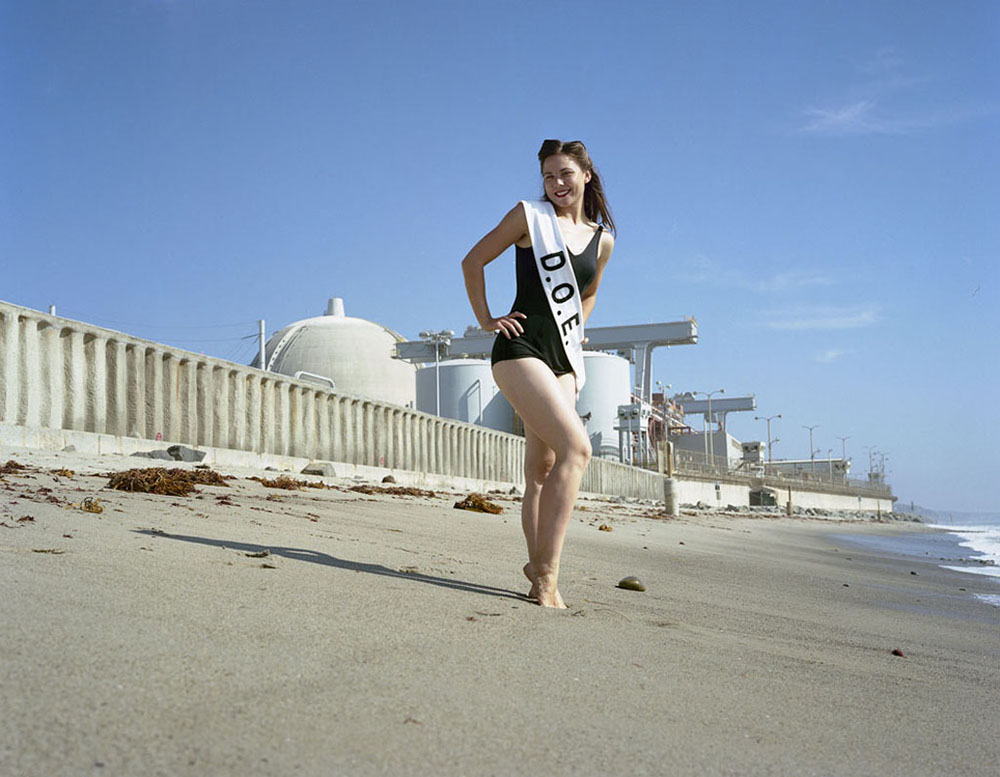
The Department of Energy Welcomes You to the California Coast (2009) by Lauren Marsden. Image courtesy the artist
And she just stands there. She stands there, and she’s somewhere in between the controversy of nuclear energy, I feel like. She’s got a certain optimism, because she stands proud, she’s kind of the pageantry of that era, but she also.. it’s kind of uncertain what she’s really doing there, because she’s alone in the landscape. So I find that’s an allegory for that particular landscape.
I got completely obsessed with that landscape because I thought how could you have this giant nuclear power plant, that is such a controversial issue, sitting right next to a public beach where children play and people surf. Like, that’s something that happens in California. That’s not something that happens in Canada. We like to hide our militarized spaces from the public. But it’s not like that in San Diego, it’s very very visible. So that was really interesting to me, and I thought, intuitively, what kind of person could be an allegory for this actual space between the public beach and the nuclear power plant? And Miss DOE is what came to me.
V: With your body, it seems like you’re inhabiting a space. And spaces are habitable. But your body is also somewhat habitable for the spaces. We were talking before about agents, about agents using objects in spaces. Do you see that there is a fluidity between bodies and persons and spaces? What is your concept of that? Because it seems they are really intimately connected. There is almost an effacement.
L: I think the way you describe it is a good way to describe it. I think there is a collaboration between the landscape and the context that a person is in. Saying “a body” sounds really detached.
The character and the landscape really do inform each other. And what’s more, there’s also the representation of that. There’s another layer here. It’s not just the place and character but then there’s how that place and character are circulated as an image. That’s also something that’s really interesting to me. The character inhabits the landscape, the landscape inhabits the character, and then they both inhabit the image. There’s definitely a circulation of relationship there.
But it’s also kind of absurd too. It’s not a one to one relationship, I don’t think. I don’t think the character always completely exemplifies the landscape that she might be in. Or vice versa. I think that there is almost a third element that happens. Because they’re often misplaced, right? If you’ve seen some of the work where there’s this character that’s in the landscape and it kind of makes sense but not really. They seem almost out of place more so than they seem in place at times. So I’m interested in that tension as well.
V: What is it like to be back in Vancouver working in this space and considering all the changes that are happening here, how is this influencing your work at this point?
L: My work has changed a lot. My work changed a lot when I moved to California, and that’s when I started doing more of the performing in the landscape kind of work because I was so compelled by the landscape and the landscape was so troubled and complicated. I had never seen so many militarized spaces in my life. Or just contentious spaces that no one else was really pointing to, that I could see – at least, artists weren’t pointing to it.
Vancouver is kind of already in a way … everyone knows that it’s in this rapid development zone and has been for a couple decades, really. I feel it’s actually very familiar that places are constantly changing here. Boundaries are always moving: neighbourhood boundaries, demographic boundaries are always shifting. That wasn’t so much the case in California. I went there with a Vancouver perspective: Oh, cities are constantly changing, rapidly changing, and it wasn’t like that down there, so I was finding other kinds of threshold spaces between one sort of land use and another that would be really obscure. And it would be in that tense butting up against each other for a long time. It wasn’t like it was rapidly changing in the same way it is here.
So I come back here after all that, performing in the landscape, and I haven’t been as inspired to that here. I think because I’m not an outsider here. When I was in California, I was an outsider, so everything was fascinating to me. I’m much more familiar with Vancouver. I have been doing work that’s based in location, I’m just not necessarily putting myself in that location. So it’s a different way of working.
I’m looking a lot at film locations right now. I’m very interested in how Vancouver’s represented, really. I think that’s the difference. It’s less of a palpable – kind of “I” as a person want to reconcile my place here, it’s that I am interested in how Vancouver is shown outside of itself. We look at how important it is in the film industry, and that’s a major way to see how Vancouver is represented even when it’s not supposed to be Vancouver.
So I’ve been studying film locations in sci fi and horror genre films that have been shot in Vancouver, going back to those locations and reshooting them as they are, and then I’m having a voice over actress describe the original scene that that location was used for in the movie. So what you get is this description of some horrific sci fi narrative over top of a really boring but sometimes beautiful landscape that you see in Vancouver. It might be the Lion’s Gate Bridge, for example. And there’s nothing happening in the image. I mean, people might be walking in and out of the frame but what you’re getting is also this narrative of how that landscape has been constructed through cinema. It’s really disjunctive so I find that really interesting. It’s not a performative piece, really, except on the part of the voice over actor. But I think it’s really interesting to think of how you can take a landscape and fictionalize it. (watch The Pit: A Study In Horror)
V: Did you want to take us to the space on Prior?
L: Yeah, we could go there.
—–
V: Did you want to talk about how you use the term you’re performing “by proxy,” with someone else, directing them. Did you want to go into that process a little bit more, and how you’re engaging with that?
L: Yep. It’s kind of a new thing for me because I spent so much time being THE performer. And actually not just posing for photographs and that kind of performance, but I was doing real stage performances and I was finding that really difficult because I’m creating the work, writing the script, determining what the documentation looks like, and performing, and often making my own costumes. And so, it was not only totally exhausting but I found I couldn’t really get outside of the work to see how it was.. to see whether it was successful or not because I was way too much in it. And also, I have terrible stage fright. Which I don’t normally tell people (laughs).
It becomes really difficult for me. So I’m starting to transition into working with other performers. This is why I’m so interested in working with the auctioneer because it’s a type of performance that I really admire. I just love how they can… I don’t want to say the word ‘manipulate,’ but their stage presence, the way they can affect a crowd, and the way they can control a space, and audience space, is just incredible to me.
And so I thought, maybe it’s better that I set up a situation in where a performer like that can do their thing, and I can guide them and I can give them a conceptual framework to work in. But really, to choreograph that experience rather than be inside of it. I think that’s quite powerful.
And I’ve worked with all kinds of other professionals too not just in a performance way. I was going to mention: one of my earliest art works was working with a vending machine merchandiser. The guy who fills the Pepsi machine, basically, where I asked the guy who fills the Pepsi machine – his name was Eric Sass – to let me take his picture, and then I wanted to replace the Pepsi bottle image on a vending machine with his portrait.
And so, it was this relationship of like, okay, do you feel okay with me taking your picture, do you mind if I blow it up larger than life, do you mind if I put it on the Pepsi machine that you’re stocking, is that okay, and so… we ended up having a great relationship. It didn’t really work in the end because Pepsi didn’t approve it (laughs) because I also asked for them to pay for it to be installed and all this stuff. They didn’t go for it. I was quite surprised, actually.
So I really like working with people who are outside the field of art because I think it’s so… there’s just a really nice product that comes out of it. I’m a person with lots of ideas, and lots of strange kind of tensions that I notice in the world around me. And then there are people who are working in these really unique professions. And I like to kind of work WITH them, you know, and bring them into the fold of my ideas… Only if they benefit from that, though. And I found, often they really do. I worked with a court illustrator (“The Sentences”), I worked with voice over actors, I worked with a filmmaker. And I’m hoping to work with a foley artist in the future, I’ll be working with dancers. You know, there are all these different kinds of professions, where I just want to see how we can collaborate.
V: Mmm hmm. So the person you’re working with your upcoming piece, The Auction #1, is actually an auctioneer?
L: Yes. She’s never done an art work in her life. So we are truly crossing over into each other’s fields with this piece. She’s performing an artwork, and not only is she performing it, she’s informing it. So we’re writing the script together. I propose a script to her and she gives me a lot of feedback: ‘Oh, this is what you’d say in an auction, here’s what my formal skills tell me,” and then together we have this script that we’ve made, a performance that we’ve made, but it’s also my first time being part of an auction. So we kind of create our love child when we do this (laughs).
V: That’s fascinating. I guess when you’re working with other people who are outside of art, which is a strange concept in itself, which is what I was going to ask you: usually, when you are talking to them about your artistic concepts, do you feel like art is just everything anyway?
L: Sometimes. I mean I think it’s also the context in which it’s presented. One thing we can say for sure is that I’m working with this auctioneer. We say the destination of this project is an art gallery. And it is predominantly an art audience. That is very clear. Everything else about the piece starts to get a little bit more expanded. You know, it’s not clear whether it’s an auction or a performance art piece. And that’s nice. I like that it’s in the space between, or among, those two kinds of ways of working. (click here for VANDOCUMENT’s coverage of The Auction #1 at Trench)
It gets a little bit elusive sometimes. Usually, I approach someone completely cold, and I’ll say, “I’m looking for an auctioneer.” I’ll look online, I find her, I have to write her this formal invitation to say, “Do you want to be part of a conceptual art event,” and I always expect to get turned down and I often don’t, but you know I like to also guarantee a certain payment for the person. You know, I don’t expect that people want to take on the risk of all the free labour that art often entails. In order to work with me, I say “What do you normally charge, okay I probably can’t afford that but I can guarantee you… you know I’ll pay you what I can just to have you show up and work with me,” and hopefully the benefits of that are beyond money, of course… You know I’m not just HIRING people to work with me. I just want to make sure that it’s safe for them to come and work with me, and then from there, the project starts to grow and everyone gains from it. Usually. I can’t say there’s ever been a time when I’ve failed at that.
But I think people are pretty open to stepping outside of their own professional comfort zone especially because I like to work with them on their own terms. Say, for example, if I’m working with a filmmaker, she’s an independent horror filmmaker, and I thought, “Well, why don’t we do an experimental video piece that’s within the genre of horror,” and so I’m not asking them to step too far outside of what they do, but I’m definitely asking them to take a different approach to something that already informs what they’re doing. So in the end, I’ll make an experimental art piece about horror film, with a horror film maker, right?
V: I find it interesting, seeing as you’re working with people in professional realms. You have your BFA from the University of Victoria and you have your Masters of Social…
L: It’s a Masters of Fine Arts in Social Practice.
V:… in Social Practice. So how has your Masters of Fine Arts in Social Practice influenced your collaborative style, or also, how has that influenced the way that you see the world in a sense, and how art is.. you use the term ‘elusive,’ the boundaries are kind of elusive, how has it influenced it?
L: It’s funny because I’m just coming to understand it now although I finished school in 2010. I didn’t particularly identify with the field of social practice because it has a certain connotation in the art world as being collaborative by nature, often there’s some kind of exchange involved, or at least this is what I found when I was in school. And I actually had a lot of problems with that kind of work, generally, so I felt like I didn’t really belong in the Social Practice department. I was interested in public space and in publics, different communities, but I didn’t necessarily want to be in a position where the artist is taking away from a community in order to make the work which is a huge pitfall of a lot of social practice art work. But then I’m finding now, a few years later, I’m in this position where I am working with people from other fields. And I have been for a long time, I just didn’t really think of it that way. I think of video and performance as inherently social practices anyway because they’re not really commodity-based, and in order to fulfill a performance or to make a film or to make a video, you need a collaboration, you need a crew. You need more than just yourself to make the work.
So there’s that, but beyond that what’s informed me is thinking about the ethics of working with people who are non-artists in order to make an artwork. And it’s very difficult. I always want to be as respectful as possible. And I won’t just work with someone for the sake of working with someone. I work with them because I’m absolutely obsessed with what they do. And I’m just fascinated with what they do and I have respect for what they do. I want to make a piece that honours what they do as a professional. And what’s more, having it not really be based on an exchange so much but be based on a real collaboration where what I say is, “Here’s what I love about what you do and can I give you an opportunity to experiment, and is that beneficial to you.” These are the questions I ask myself when I approach someone I don’t know, I haven’t worked with before, who’s not an artist. If all signs are pointing to ‘yes,’ then we can move forward in a respectful way and make a piece.
So yeah the social practice things is complicated (laughs). I have a complicated relationship with it (laughs). But clearly it’s informed me because I was surrounded by artists who were working with other communities, and when I say ‘other,’ I mean the art communities. Like for example, let’s go have a potluck with a group of single mothers in a housing complex. That kind of thing. It’s not the kind of work that I’m really that interested in because it’s usually based on trying to remediate a troubled social situation. It has a bit of a social work aspect to it.
I’m not as interested in that kind of work that’s trying to mediate a social condition that might be troubled, that’s trying to solve a social problem. And there’s a lot of work like that out there. So there’s a bit of a difference for me. I think social practice artists… there’s a tendency to colonize other kinds of practices, to take away from them, to say, “Oh, I’m working with a group of chefs, and to say, I’m going to bring that into my art work, and almost like there’s not really a collaboration going on there. I see that happen a lot and I see that to be a huge flaw, from my opinion. But a lot of people work that way. So I’m always asking myself, “Am I colonizing this person’s practice, or am I honouring it?” And it’s sometimes hard to tell. I feel pretty strong about the works that I do, it’s sometimes hard for me to tell in other people’s work if they are being respectful in how they work with other professionals or other communities, especially when there’s representation involved, especially when they’re being represented through video, photography, and that kind of thing, for it to be done in a non-exploitive way, it’s very difficult. It’s a hard job.
I mean another thing too is I’m so interested in performance. And I love to see different kinds of performance. Because actually I think performance artists are often terrible performers and don’t necessarily have performance training. And I know that’s true for me too, right? So I got to this place where I thought, “Well why don’t I work with REAL performers?” People who really do it for a living. And so that’s why I’ve been starting to think more about actors, dancers, auctioneers, you know, this kind of thing, voice over actors, the REAL professionals.
V: Talking about the performers: those performers are actually performers in public spaces. So they’re not necessarily recognized as being performers because they have some sort of, there’s just a certain understanding, I suppose, that this is their profession. So talking about public and private spaces, do think that sometimes art is kind of a private space, or a private endeavour, and that your understanding through your MFA, understanding that those public spaces are not necessarily distinct from the private spaces?
L: Well, I don’t know that I would say that art is a space that is private. So I think that’s a difficult question for me to answer. I don’t know if I agree with that distinction.
I was not interested in gallery space. Some people could say that the gallery is a private space because it has a lot of exclusionary attributes. It has a sort of intimidation factor, or in some cases, a museum that charges a fee, like an entrance fee, can make it to feel like it’s not as much a public space as we’d like it to be. So I recognize that. But it’s not really been that interesting to me because I wasn’t making work for galleries for a long time. I mean, I still rarely do. I feel like I’m more interested in spaces that have a wider variety of audiences. Like the antique mall is a great example. The antique mall has it’s own public. People who are antique buyers. And then we brought, what’s leaning more towards an art audience. So I don’t see a huge distinction between the two honestly. I don’t think it’s so black and white.
V: Definitely. Sorry, that was kind of where my question was going. I feel like the way that you’re presenting your characters, and also working with people, like you were saying, who are professionals in different areas, how that divides; there’s a strange elaboration…
L: Yeah, it does start to get strange though. And there is a difference between a truly public space like a park, a kind of ideal public space, and a gallery. I recognize that difference. I guess all I can really say about that is that when I’m asked to do a piece for a gallery, I struggle with it a lot because I find it to be this, you know, attempting to be a neutral space, but no space is really neutral or a depoliticized space, and I struggle with that because every other space I work in is totally politicized. Any urban, public, outdoor space or architectural space has spatial politics to it and the gallery is trying to negate that often.
Actually, this upcoming performance is very much in response to the gallery space as a political space. Because I can’t NOT react to the context, right? So this is what happens: curators get upset with me sometimes when they ask me to be in the show and then I just end up critiquing the gallery (laughs). It’s like, that’s what you get (laughs).
Not critiquing like I think it’s a terrible space, it’s just responding to it, responding to that construct of gallery spaces. It’s interesting to me to a certain extent but there are so many other kinds of spaces to work in that are so interesting to me as well.
V: So then, what are your objectives then on a whole, you know if you look at everything you do, what is your objective as an artist?
L: Oh wow, to sum it up. I’m supposed to have my – they always say in grad school, “You have to have your elevator pitch,” and I don’t think I ever dealt with it (laughs).
V: Can we do one of those 3 words – just give me three words, they don’t even have to be connected, not even a formal sentence – three words of what objective you have.
L: I think that… oh god, in three words?
V: I don’t know (laughs).
L: (laughs) Wow, that’s hard. I don’t know if I can get it down to three words, but I could say – I’ll quote one of my advisors from grad school and he said, “If you are interested enough in it, other people will be too.”
And so, I know that’s a really vague thing to say, but you know we’re always pressured as artists to come up with the artist’s statement, what is it that you’re doing… Honestly, I just get so interested in certain things that I pursue them ferociously and then make a work. Sometimes a work doesn’t even manifest from it, but it could even just be one location, I’m just obsessed with this one location and I have to do something with it or a particular phrase like the flag that’s behind you.
I was obsessed with that phrase for MONTHS. So I made a flag out of it and I actually did a flag raising performance (laughs) I just couldn’t get it out of my mind, and it was related to the site, but I just couldn’t…
V: (reading) “Vast Untapped Potential”
L: Yeah. I just read it in a newspaper that was talking about a neighbourhood that was being developed. An old militarized zone that was being redeveloped and I just thought that’s such a strange phrase. I’m just going to steal it and make a ceremony out of it, do a flag raising performance, and then I kind of get it out of my system (laughs). (Watch a video of “Vast Untapped Potential”)
V: Was it one of your other characters that did that?
L: Yeah that was Mildred “Millie” Garrison. She’s a 1940’s naval officer
V: Also known as the Freelance boat Christener (laughs)
L: Oh yeah, if you ever need anything to be Christened with a champagne bottle, she’s available, yeah (laughs).
V: (laughs) Well, thank you. I am actually really excited to get you out in a space to talk about, and seeing as it’s right up the road…
L: It’s definitely related to the things we’ve been talking about, for sure.
—
Hogan’s Alley site visit: artist Lauren Marsden talks with VANDOCUMENT about the history of Hogan’s Alley, and her work there
Artist Lauren Marsden takes VANDOCUMENT’s Celesse McCarthy and Sheng Ho to the site of her 2007 work, “Hogan’s Alley Welcomes You,” where she explains the neighbourhood’s history, and how her involvement with the people of the Hogan’s Alley Memorial Project began her ongoing collaborations with non-artists and communities.
Hogan’s Alley site visit: artist Lauren Marsden talks with VANDOCUMENT about the history of Hogan’s Alley, and her work there from VANDOCUMENT on Vimeo.
—
For more information, visit Lauren Marsden’s site laurenmarsden.com
Founder of VANDOCUMENT. Photographer, illustrator, lover and supporter of arts & culture.

